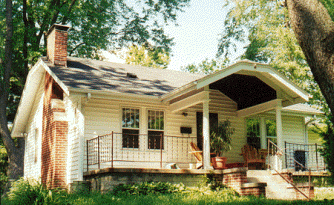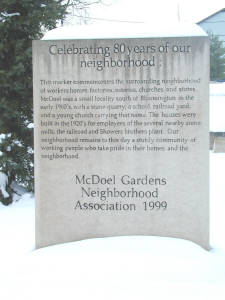|
The McDoel Gardens Neighborhood holds a significant place in the industrial history of Bloomington. McDoel started as a community of about 150 people living on farms and houses surrounding the Monon Route. The railroad yards abutted Morton, and provided many jobs for area residents. McDoel Gardens officially got its name in 1910 when the railroad Company formally named their yards after the president of the Company, W.H. McDoel (president from 1899-1909). The Gentry Family also owned land in the area and housed the Gentry Brothers Circus' animals during their off-peak months, providing for some very interesting neighborhood legends. Eleven stone mills also dotted the area, providing more jobs for the community. Only the Dodds subdivision had been built before 1919 and as industry increased, including a new kitchen cabinet factory by the Showers Brothers on South Roger in 1919, workers were more inclined to live near their workplace and began to build a greater community surrounding these sites. The oldest house in the area is the Henderson Home (748 S. Morton). It dates from the 1830's and is folk hall and parlor type that was redesign to resemble an I House form, common to the Mid-west. Most of the earlier houses consisted of the gable-ell style, and other small houses known in their day as "carpenter architecture." These preceded the well known catalogue kit homes, but were a similar solution to simple housing needs. By 1910 there were 63 houses and about 274 people living in the neighborhood, mostly employed by the railroad. Bloomington's first hospital began in a two story brick farm house on S. Rogers, North of First. A property at the south end of the neighborhood (321 W. Hillside) has a major connection to the Railroad history. They served as hotels and boarding houses for railroad workers or travelers coming through, they were known as the "Monon Hotel." |
|

|
Major developments happened in the twenties caused by three different occurrences: The beginning of the Showers Brother Furniture Factory, the sub-dividing of the Gentry Farm into the Dixie Highway Addition, and the boom of Sears and Roebuck kit home sales. The c. 1919 Showers newsletter extols the virtues of living close by their employment, describing the nearby lots and neighborhoods, and Kit Homes were readily available and affordable. Bungalows were one of the more popular house types in this area, adding to the quaint qualities of the growing close knit neighborhood. The McDoel Baptist Church was built on the corner or Allen and Rogers, creating a neighborhood cornerstone, and commercial buildings also entered, including restaurants, a grocery, a barber, a filling station, and a candy store, mostly along Rogers. |
|
The neighborhood held up under the depression thanks to the steady jobs offered by the railroad, the mills and the Showers Company. The WPA reached the neighborhood with pieced limestone sidewalks along many of the streets, and the neighborhood seemed to float through the Great Depression without too much grief. In the Forties though, things began to change. The neighborhood was as strong as it could be, still mostly employed by the railroad, but the Showers Brothers Plant on Rogers was taken over by the Radio Corporation of America. Another cause for change was the popularity of automobiles. In 1910 three quarters of the population of the neighborhood was employed in the general vicinity, while in the forties this ratio was reversed. Most of the workers left the neighborhood during the days for work, with the ease of the automobile. The Second World War was also a contributing factor to the changes in the neighborhood, as it was to the rest of the country, taking many people overseas, and affecting the general population as well as the moral. The McDoel Gardens Neighborhood today is a variety of historic homes of a particular time of Historical and Architectural growth in Bloomington. Though most people these days work outside of where they live, it is still a proud and thriving neighborhood that remembers where it came from. |
|
McDoel Baptist Church on Rogers St.




